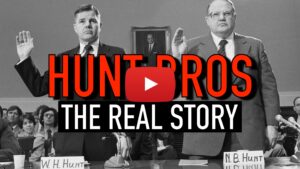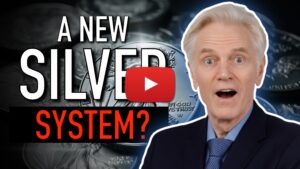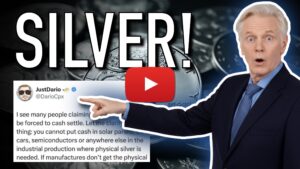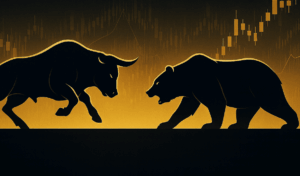A record $7.5 trillion now sits in money market funds. Investors call it “parked,” “safe,” and “risk‑free.” Mike calls it what it is: an IOU with counterparty risk. Money markets are promises—useful in calm seas, fragile in storms. In the episode, Mike and Alan walk through why that matters now: when confidence wobbles, “safe” cash looks for real safety.
The pattern no one talks about: money market balances tend to surge before major crises—Dot‑Com, GFC, COVID. After each shock, those balances shrink as capital runs to hard assets. Their read: we’re seeing that pre‑shock surge again.
“When this goes south next time, a lot of it is going to be headed toward gold and silver.” — Mike
A money market fund depends on someone else keeping a promise. Gold and silver don’t. That’s the core difference between an IOU and an ounce.
The Policy Trap: Why the Next Rescue Could Be the Biggest Yet
Mike’s base case is blunt: either we get the biggest crash in history or policymakers try to stop it with the biggest print in history—what he nicknames QE5. Here’s the logic chain from the show:
- Financialization of government: When markets roll over, tax receipts fall and deficits spike. That pushes authorities toward more currency creation.
- Each rescue weakens the foundation: Quick fixes (“band‑aids”) inflate the next bubble instead of letting the excess clear.
- Printing favors asset owners: Every round of monetary experimentation tends to enrich holders of financial assets and dilute purchasing power for everyone else.
If the playbook repeats—rate cuts into all‑time‑high assets, emergency programs, and fresh liquidity—gold and silver historically benefit as neutral, non‑debt money.
The Wealth Gap, in One Brutal Stat
Alan highlights a “shocking stat of the day”: the bottom 50% of U.S. households hold just ~2.5% of total wealth. The show connects that reality to decades of currency expansion and policy interventions that inflate asset prices faster than wages and savings can keep up.
Two visual points from Mike:
- On a log scale, the share for the bottom half has been shrinking for decades, especially post‑1971 (the end of the gold link).
- Post‑2008 changes (QE, ZIRP) re‑wired how currency enters the system, disproportionately supporting financial asset holders.
In a system that serially boosts asset prices, those without hard assets fall behind. That’s partly why Mike and Alan frame gold and silver as “saving”—not speculation. You buy, you hold, your ounces don’t depend on anyone else’s promise.
“Everything at Records” Isn’t Normal
The episode ticks through an extraordinary setup: S&P 500 at highs, home prices at highs, Bitcoin at highs, gold at highs, money supply and public debt at highs, while labor data get revised down and the real economy looks weak. Corporate buybacks further muddy the picture—EPS can rise even if total earnings don’t, simply by shrinking share counts.
Mike’s point isn’t to scare—it’s to show why this environment is fragile. When everything levitates on easy money and narrative, small shocks hit harder. That’s when perceived safety morphs into a preference for real safety.
Saving vs. Investing: A Simpler Path to Resilience
Alan previews his upcoming series, Hidden Secrets of Value, starting with a simple frame: saving (gold & silver) vs. investing (IOUs and abstractions). For thousands of years, people could simply save in money itself—gold and silver—and watch productivity gains lift purchasing power over time.
In today’s fiat world, everyone’s forced to be an “investor,” whether they want to be or not. Mike and Alan offer an alternative: own some money with no counterparty risk so your long‑term purchasing power isn’t at the mercy of policy.
Practical next steps to consider:
- Clarify your “safety” bucket. Ask what portion of your reserves you want in promises vs. ounces.
- Match form to purpose. Long‑term savings? Consider vaulted bullion with liquidity. Near‑term optionality? Blend allocated storage with the ability to take delivery.
- Think in ounces, not just dollars. Your true yardstick is purchasing power over time.
Where Smart Money Runs
If history rhymes, a meaningful slice of the $7.5T in “safe” cash may not stay put when fear returns. Gold and silver — no counterparty, no IOU — are where panicked capital often runs. The time to decide what “safety” means to you is before the crowd moves.
Explore your options: Open a secure, insured storage account and start building your position in minutes.
Get Gold & Silver Insights Direct to Your Inbox
Join thousands of smart investors who receive expert analysis, market updates, and exclusive deals every week.








